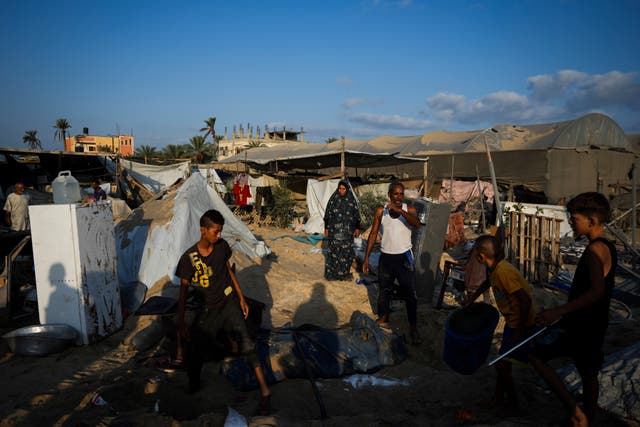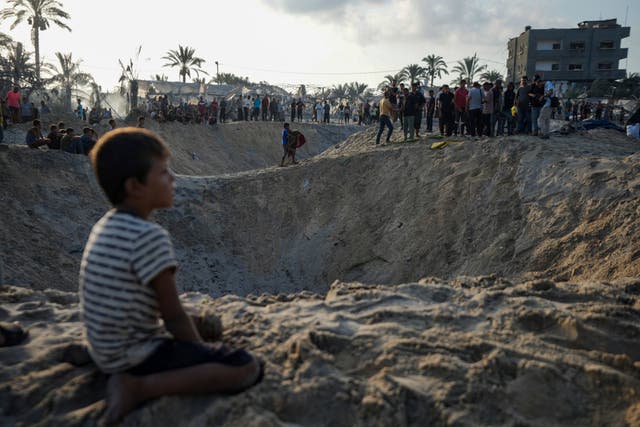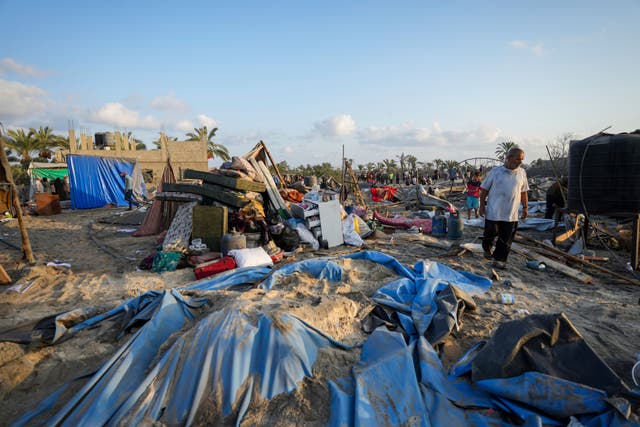At least 19 killed in Israeli strike on Gaza tent camp, say Palestinians
The Civil Defence, first responders who operate under the Hamas-run government, had earlier said 40 people were killed.

An Israeli strike on a crowded tent camp housing Palestinians displaced by the war in Gaza killed at least 19 people and injured 60 others early on Tuesday, Palestinian officials said.
Israel said it had targeted senior Hamas militants with precise munitions.
The overnight strike hit Muwasi, a sprawl of crowded tent camps along the Gaza coast that Israel designated as a humanitarian zone for hundreds of thousands of civilians to seek shelter from the Israel-Hamas war.
Gaza’s Health Ministry said it confirmed that at least 19 people were killed in the strike, and that the toll may rise as more bodies are recovered.

The Civil Defence, first responders who operate under the Hamas-run government, had earlier said 40 people were killed. The Israeli military disputed that toll.
The ministry is also part of the Hamas-run government but its figures are widely seen as generally reliable. It maintains detailed records and its tallies from previous wars have largely coincided with figures from independent researchers, the United Nations and even the Israeli military.
Both the Health Ministry and the Civil Defence did not immediately respond to a request for comment on the discrepancy of their tolls.
Associated Press footage showed three large craters at the scene.
First responders dug through the sand and rubble with garden tools and their bare hands, using mobile phone torches until the sun came up.
“We were told to go to Muwasi, to the safe area… Look around you and see this safe place,” said Iyad Hamed Madi, who had been sheltering there.
“This is for my son,” he said, holding up a bag of nappies. “He’s four months old. Is he a fighter? There’s no humanity.”

One of three hospitals that took in casualties from the strike, Nasser Hospital in Khan Younis, said around two dozen bodies had been taken in.
An Associated Press cameraman saw 10 bodies in the hospital’s morgue, including two children and three women.
“We were sleeping, and suddenly it was like a tornado,” Samar Moamer told the AP at the hospital, where she was being treated for injuries from the strike.
She said one of her daughters was killed and the other was pulled alive from the rubble.
The Israeli military said it had struck Hamas militants in a command-and-control centre embedded in the area. It identified three of the militants, saying they were senior operatives who were directly involved in the October 7 attack and other recent attacks against Israel and Israeli forces.
Israeli military spokesman Rear Admiral Daniel Hagari disputed the initial reports of the number of casualties in a post on X, formerly Twitter, saying they “do not line up with the information available to the (Israeli army), the precise weapons used and the accuracy of the strike”.
Hamas released a statement denying any militants were in the area, calling the Israeli allegations a “blatant lie”.
Neither Israel nor Hamas provided evidence to substantiate their claims.

Israel has said it tries to avoid harming civilians and blames Hamas for their deaths because the militants often operate in residential areas and are known to position tunnels, rocket launchers and other infrastructure near homes, schools and mosques.
In July, Israel carried out a strike in the humanitarian zone that killed at least 90 Palestinians. The military said it targeted and killed Mohammed Deif, the shadowy leader of Hamas’s military wing, but Hamas said he is still alive.
International law allows for strikes on military targets in areas where civilians are present, provided the force used is proportionate to the military objective – something that is often disputed and would need to be settled in a court, which almost never happens.
The war has caused vast destruction and displaced around 90% of Gaza’s population of 2.3 million, often multiple times.
Israeli evacuation orders, which now cover around 90% of the territory, have pushed hundreds of thousands of people into Muwasi, where aid groups have struggled to provide even basic services.
Gaza’s Health Ministry says more than 40,900 Palestinians have been killed since the war began. It does not distinguish between civilians and militants in its count, but says women and children make up just over half of the dead. Israel says it has killed more than 17,000 militants in the war.
Hamas-led fighters killed some 1,200 people, mostly civilians, in their October 7 attack on Israel.
They abducted another 250 people and are still holding around 100 hostages after releasing most of the rest in exchange for Palestinians imprisoned by Israel during a weeklong ceasefire last November. Around a third of the remaining hostages are believed to be dead.

The United States and mediators Egypt and Qatar have spent much of this year trying to broker an agreement for a ceasefire and the release of the hostages, but the talks have repeatedly been bogged down as Israel and Hamas have accused each other of making new and unacceptable demands.
UK Foreign Secretary David Lammy, speaking at a news conference in London with US secretary of state Antony Blinken, said the continued violence underscored how important it was to forge a ceasefire.
“The shocking deaths in Khan Younis only reinforce how desperately needed that ceasefire is,” Mr Lammy said.
Israeli Defence Minister Yoav Gallant told reporters on Monday that conditions are ripe for at least a six-week suspension of the fighting that would include the release of many of the hostages still held in Gaza.
However, he would not commit to a permanent end to the fighting, as Hamas has demanded, raising questions about the feasibility of a deal.
The war has plunged Gaza into a severe humanitarian crisis, and aid groups have struggled to operate because of ongoing fighting, Israeli restrictions, and the breakdown of law and order. The international authority on the severity of hunger crises said in June that the territory is at high risk of famine.
The main United Nations agency providing aid to Palestinians said Israeli troops stopped a convoy taking part in a polio vaccination campaign for more than eight hours on Monday, despite it co-ordinating with the military.
UNRWA head Philippe Lazzarini said the staff members who were held had been taking part in the campaign in northern Gaza and Gaza City.
He wrote on X that the convoy was stopped at gunpoint and that “heavy damage was caused by bulldozers” to the UN armoured vehicles.
The Israeli military said it held up the convoy based on intelligence indicating the presence of suspected militants. It said the suspects were questioned and released.
Israel has long accused UNRWA of having ties to militant groups, allegations the UN agency denies.
The vaccination drive, launched after doctors discovered the first polio case in the Palestinian enclave in 25 years, aims to vaccinate 640,000 children during a war that has destroyed the healthcare system.





